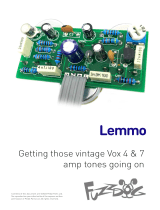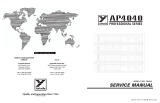Page is loading ...

Model T
Emulating a Sunn Pre-Amp
for Doomy heaven
Contents of this document are ©2019 Pedal Parts Ltd.
No reproduction permitted without the express written
permission of Pedal Parts Ltd. All rights reserved.

Important notes
If you’re using any of our footswitch daughterboards,
DOWNLOAD THE DAUGHTERBOARD DOCUMENT
•Download and read the appropriate build document for the daughterboard
as well as this one BEFORE you start.
•DO NOT solder the supplied Current Limiting Resistor (CLR) to the main
circuit board even if there is a place for it. This should be soldered to the
footswitch daughterboard.
POWER SUPPLY
Unless otherwise stated in this document this circuit is designed to be
powered with 9V DC.
COMPONENT SPECS
Unless otherwise stated in this document:
•Resistors should be 0.25W. You can use those with higher ratings but
check the physical size of them.
•Electrolytics caps should be at least 25V for 9V circuits, 35V for 18V
circuits. Again, check physical size if using higher ratings.
LAYOUT CONVENTIONS
Unless otherwise stated in this document, the following are used:
•Electrolytic capacitors:
Long leg (anode) to square pad.
•Diodes/LEDs:
Striped leg (cathode) to square pad. Short leg to square pad for LEDs.
•ICs:
Square pad indicates pin 1.

R1 68K
R2 1M
R3 680R
R4 150K
R5 47K
R6 56K
R7 68K
R8 1M
R9 680R
R10 100K
R11 150K
R12 820R
C1 220p
C2 22n
C3 22n
C4 270p
C5 220p
C6 470p
C7 22n
C8 22n
C9 270p
C10 22u elec
C11 220u elec
C12 220u elec
C13 100u elec
Q1-4 J201*
D1 14001
BASS 1MB
BRITE 1MA
MAST 100KA
MID 25KB
NORM 1MA
TREB 250KB
T1-3 47-50K trim
S1** DPDT ON-ON-ON
Schematic
+ BOM
*You can use through-hole J201 or SMT MMBFJ201
**You can use a DPDT ON-ON if you only want to switch between the two channels. If you want to
have the option of running both in parallel you’ll need a DPDT ON-ON-ON. These come in
different configurations. You need one with the following connections in the three positions:
Tayda stock this
particular type.


The power and signal pads on the PCB conform
to the FuzzDog Direct Connection format, so
can be paired with the appropriate
daughterboard for quick and easy offboard
wiring. Check the separate daughterboard
document for details.
Be very careful when soldering the FETs and
diode. They’re very sensitive to heat. Keep
exposure to heat to a minimum (under 2
seconds) and leave a few seconds between
soldering each leg.
You should solder all other board-mounted
components before you solder the pots. Once
they’re in place you’ll have no access to much of
the board. Make sure your pots all line up nicely.
The best way to do that is to solder a single pin
of each pot in place then melt and adjust if
necessary before soldering in the other two
pins. Same for the toggle switch. If your pots
don’t have protective plastic jackets ensure
you leave a decent gap between the pot body
and the PCB otherwise you risk shorting out
the circuit.
Snap the small metal tag off the pots so they
can be mounted flush in the box.
When you’re doing your final wiring you can use
the V and G pads on either the daughterboard or
the main PCB to connect to your DC socket.
PCB layout ©2019 Pedal Parts Ltd.

Biasing
Once you have everything soldered up and hooked up for testing (see next page) you
need to bias the FETs.
The trimmer numbering ties up with the FET numbering, so T1 adjusts Q1 etc.
There’s no adjustment for Q4.
Adjust each trimmer until the Drain pin of the corresponding FET measures around
4.5-5V. You’ll need a multimeter to do this. Set it to DC Voltage, put your Common
probe onto any ground point, and the other probe onto the Drain of the FET being
tested.

Testing
You can test the Distortion and Boost sections
individually, as if they’re separate boards. Do the test
wiring as shown below for each section.
UNDER NO CIRCUMSTANCES will troubleshooting help
be offered if you have skipped this stage. No exceptions.
Solder some nice, long lengths of wire to the board connections for 9V, GND, IN and OUT. Connect
IN and OUT to the jacks as shown. Connect all the GNDs together (twist them up and add a small
amount of solder to tack it). Connect the battery + lead to the 9V wire, same method. Plug in. Go!
You’ll have to connect the wire from pad O2 to either O1 or O3, or you’ll get no signal from the
Distortion section.
There’s no need to connect power to the OV and OG pads - these are purely to supply power to an
LED if you’re adding the Octave footswitch.
If you have a circuit tester (we sell a few!) just use that as normal.
Your completed circuit board
including pots

Wiring shown above will disconnect the battery when you remove the jack plug
from the input, and also when a DC plug is inserted.
The Board GND connections don’t all have to directly attach to the board. You
can run a couple of wires from the DC connector, one to the board, another to
the IN jack, then daisy chain that over to the OUT jack.
It doesn’t matter how they all connect, as long as they do.
This circuit is standard, Negative GND. Your power supply should be Tip
Negative / Sleeve Positive. That’s the same as your standard pedals (Boss etc),
and you can safely daisy-chain your supply to this pedal.
L
E
D
BOARD
OUT
BOARD
9V
BOARD
GND
BOARD
GND
BOARD
GND
BOARD
INPUT
BATTERY
+
IN
OUT
L
E
D
BOARD
GND
BOARD
9V
+
Wire it up (if using a daughterboard please refer to the relevant document)

FuzzDog.co.uk
Drilling template
Hammond 1590BB
It’s a good idea to drill the pot and toggle switch holes
1mm bigger if you’re board-mounting them.
Recommended drill sizes:
Pots 7mm
Jacks 10mm
Footswitch 12mm
DC Socket 8/12mm
Toggle switches 6mm
30mm
27mm
/












